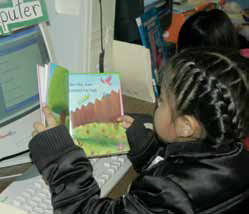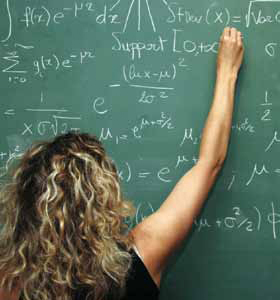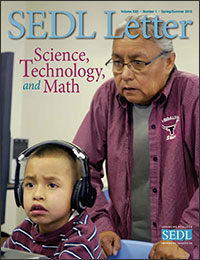Research Update: Encouraging Girls in Math and Science
Women are attending and completing college at higher rates than ever. Despite these gains, women are still underrepresented in the fields of math and science. At the bachelor's level, women account for nearly half of the math degrees awarded and the majority of degrees awarded in health-related fields. In the areas of physics, computer science, engineering, and chemistry, women earn a much smaller percentage of degrees. As students move on to the graduate level, the percentage of women earning degrees in these fields declines even more. These disparities continue in the work force. Although women make up nearly half of the total U.S. work force, they compose only 27% of the work force in science and engineering (NSF, 2010). With the high demand for workers in math and science fields, and because these fields usually pay more than the social sciences or humanities, some researchers are focusing on why fewer women pursue degrees and professions in math and science. Encouraging Girls in Math and Science (Halpern et al., 2007), a practice guide released by the U.S. Department of Education's Institute of Education Sciences (IES), examines the reasons women don't pursue these fields and what educators can do to encourage them to do so.
Encouraging Girls in Math and Science

Girls who have a strong belief in their math and science skills are more likely to choose courses and careers in these fields.
The authors begin by examining assumptions about differences in men's and women's abilities in math and science, noting that "experts disagree among themselves on the degree to which women and men differ in their math- and science-related abilities" (p. 3). Concluding that women's and men's choices in areas of study and professions cannot simply be attributed to natural ability, the authors examine the influence of previous course work, ability, interests, and self-confidence in women's decisions. Their findings show that, although some gender difference among secondary course preferences exists, girls complete high school math and science courses at roughly the same rate as boys. The authors suggest, however, that high school graduation requirements may contribute to the gender parity in course completion. Studies also show that girls generally outperform boys on high school homework assignments and course grades, while young men tend to "outscore girls when tested on the same content in high-pressure situations, such as standardized tests with time limits" (pp. 4, 6). The authors assert that the difference in standardized test scores is not always reflected in college performance. For example, young women are likely to perform just as well in college math courses (p. 6).
Where consistent gender differences have emerged, the authors argue, are in students' beliefs about their abilities and their interest in math and science. They note that researchers have found that girls and women have less confidence in their abilities in math and science. In addition, from early adolescence on, girls show less interest in pursuing careers in math and science. This trend is not universal, however. Girls who have a strong belief in their math and science skills are more likely to choose courses and careers in these fields. The authors thus conclude that the key to encouraging girls to pursue these fields lies in boosting their confidence in their skills (p. 6).
Recommendations
Based on this conclusion, the authors outline five recommendations for encouraging girls and women to choose career paths in math- and science-related fields. To accompany each recommendation, the authors provide an explanation of the level of evidence that supports it. This evidence includes experiments, trends in the National Assessment of Educational Progress data, and correlation and longitudinal studies. Below is a summary of the authors' recommendations and suggestions for implementation. (For the full report, go to http://ies.ed.gov/ncee/wwc/publications/practiceguides.)
Recommendation 1: Teach students that academic abilities are expandable and improvable.
The authors encourage educators to share with their students that "math and science abilities—like all abilities—can be improved through consistent effort and learning" (p. 11). Indeed, research shows that students' positive or negative views of their capacity to improve their academic abilities can determine whether they encounter success or increased frustration. To carry out the recommendation, educators may want to share and discuss neuroscience research with students, explaining how the brain grows new synaptic connections when new material is learned and practiced. Teachers may also want to use sports analogies to illustrate how practicing free throws in basketball or serves in tennis improves an athlete's performance (pp. 11–13).
Recommendation 2: Provide prescriptive, informational feedback.
When providing prescriptive, informational feedback, teachers typically focus on strategies, effort, and the process of learning. This type of feedback, explain the authors, can often prove more effective than simply giving students a grade or test score. Providing prescriptive feedback that acknowledges learning strategies that students use and the effort they put forth can have a greater impact on how students perceive their learning abilities and, ultimately, their academic performance. Educators can provide this type of feedback by creating an environment where they treat students' mistakes as learning opportunities and where children can reflect on and correct problem-solving strategies. Teachers can also emphasize effort over innate intelligence for completing difficult tasks (pp. 15–17).
Recommendation 3: Expose girls to female role models who have succeeded in math and science.

Exposure to positive role models has been found to have a positive impact on young women's math performance and can help dispel negative stereotypes.
Negative stereotypes can have a negative impact on young women when they complete tests of mathematics and spatial reasoning. At the same time, exposure to positive role models has been found to have a positive impact on young women's math performance and can help dispel negative stereotypes. To help students find positive role models, the authors suggest that teachers assign biographical readings about women scientists, mathematicians, and engineers. Educators can also draw students' attention to current achievements of women in math and science and possibly invite women or older female students to speak to classes about their experiences in these fields (pp. 19–22).
Recommendation 4: Create a classroom environment that sparks initial curiosity and fosters long-term interest in math and science.
When students are interested in a subject, including math and science, they are likely to earn better grades, take advanced courses, and ultimately select college majors in that field. By piquing students' curiosity in a specific activity or topic, teachers can begin cultivating long-term interest in a subject. To pique curiosity in math and science, the authors recommend that teachers provide word problems and science activities in contexts that are interesting to students. For example, elementary students might solve math problems to discover the location of a buried treasure. Middle school students might enjoy the challenge of figuring out how to build an effective skateboard ramp on a limited budget. Project-based learning, group work, innovative tasks, and technology are all ways to spark students' interest in math and science (pp. 23–25).
Recommendation 5: Provide spatial skills training.
The authors cite research associating spatial skills with performance on math tests and note that practicing certain tasks can improve a person's spatial skills. Educators can help girls work on their spatial skills in the following ways: encourage young girls to play with toys that require the application of spatial knowledge; and ask students to provide answers in both words and spatial representation; and provide opportunities for specific training in spatial skills (pp. 27–29).
References
- Halpern, D., Aronson, J., Reimer, N., Simpkins, S., Star, J. R., & Wentzel, K. (2007). Encouraging girls in math and science: IES practice guide (NCER 2007–2003). Washington, DC: National Center for Education Research, Institute of Education Sciences, U.S. Department of Education. Available from http://ies.ed.gov/ncee/wwc/publications/practiceguides/
- National Science Foundation. (2010). Science and engineering labor force. In Science and engineering indicators 2010 (p. 3-6). Retrieved from http://www.nsf.gov/statistics/seind10/pdf/c03.pdf
Next Article: Connecting Kids to Mathematics, Science, and Technology

